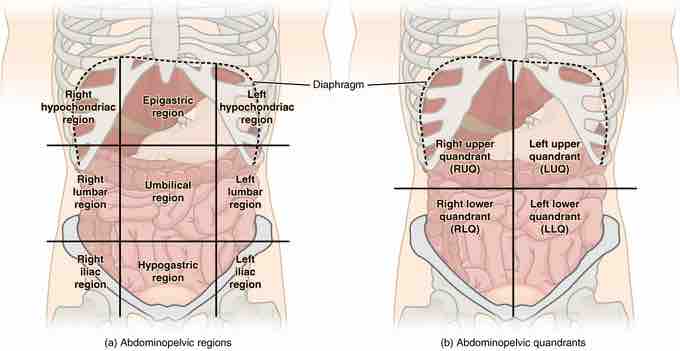Anatomists and medical personnel divide the abdominopelvic cavity into smaller regions to facilitate study and discussion. These divisions are often used to categorize the individual abdominal organs by their location and function and are used by clinicians to help diagnose the source of abdominal pain and determine appropriate treatment. The most common divisions for the abdominopelvic region are the four quadrants and nine regions.

Abdominal nine divisions (a) and quadrant regions (b)
The abdomen is subdivided into four quadrants and nine areas.
Abdominal Four Quadrants
The abdominopelvic region can be divided into four quadrants. These quadrants are defined by the intersection of the saggital plane with the umbilical plane (the transverse plane through the navel). Clinicians use these regions to determine the organs and tissues that may be causing pain or discomfort in that region.
Right Upper Quadrant
The right upper quadrant contains the right portion of the liver, the gallbladder, right kidney, a small portion of the stomach, the duodenum, the head of the pancreas, portions of the ascending and transverse colon, and parts of small intestine. Pain in this region is associated with infection and inflammation in the gallbladder and liver or peptic ulcers in the stomach.
Left Upper Quadrant
The left upper quadrant is the location of the left portion of the liver, part of the stomach, the pancreas, left kidney, spleen, portions of the transverse and descending colon, and parts of the small intestine. Pain in this region is associated with malrotation of the intestine and colon.
Right Lower Quadrant
In the right lower quadrant sits the cecum, appendix, part of the small intestines, the right half of the female reproductive system, and the right ureter. Pain in this region is most commonly associated with appendicitis.
Left Lower Quadrant
The left lower quadrant houses the majority of the small intestine, some of the large intestine, the left half of the female reproductive system, and the left ureter. Pain in this region is generally associated with colitis (inflammation of the large intestine) as well as pelvic inflammatory disease and ovarian cysts in females.
Abdominal Nine Divisions
The nine divisions of the abdominopelvic region are smaller than the four quadrants, allowing for a more detailed discussion. These divisions are marked by two parasagittal and two transverse planes centered around the navel. Most organs are part of multiple regions, including the gallbladder, duodenum, stomach, kidneys, spleen, small intestine and colon. The perineum (the area beneath the hypogastric region at the bottom of the pelvic cavity) is sometimes considered to be a tenth division in this system.
Right Hypochondriac
The right hypochondriac region contains the right portion of the liver, the gallbladder, the right kidney, and parts of the small intestine.
Left Hypochondriac
The left hypochondriac region contains part of the spleen, the left kidney, part of the stomach, the pancreas, and parts of the colon.
Epigastric
The epigastric (above stomach) region contains the majority of the stomach, part of the liver, part of the pancreas, part of the duodenum, part of the spleen, and the adrenal glands. This region pushes out when the diaphragm contracts during breathing.
Right Lumbar
The right lumbar region consists of the gallbladder, the left kidney, part of the liver, and the ascending colon.
Left Lumbar
The left lumbar region consists of the descending colon, the left kidney, and part of the spleen.
Umbilical
The umbilical region contains the umbilicus (navel), and many parts of the small intestine, such as part of the duodenum, the jejunum, and the illeum. It also contains the transverse colon (the section between the ascending and descending colons) and the bottom portions of both the left and right kidney.
Right Iliac
The right iliac region contains the appendix, cecum, and the right iliac fossa. It is also commonly referred to as the right inguinal region. Pain in this area is generally associated with appendicitis.
Left Iliac
The left illiac region contains part of the descending colon, the sigmoid colon, and the right illiac fossa. It is also commonly called the left inguinal region.
Hypogastric
The hypogastric region (below the stomach) contains the organs around the pubic bone. These include bladder, part of the sigmoid colon, the anus, and many organs of the reproductive system, such as the uterus and ovaries in females and the prostate in males.